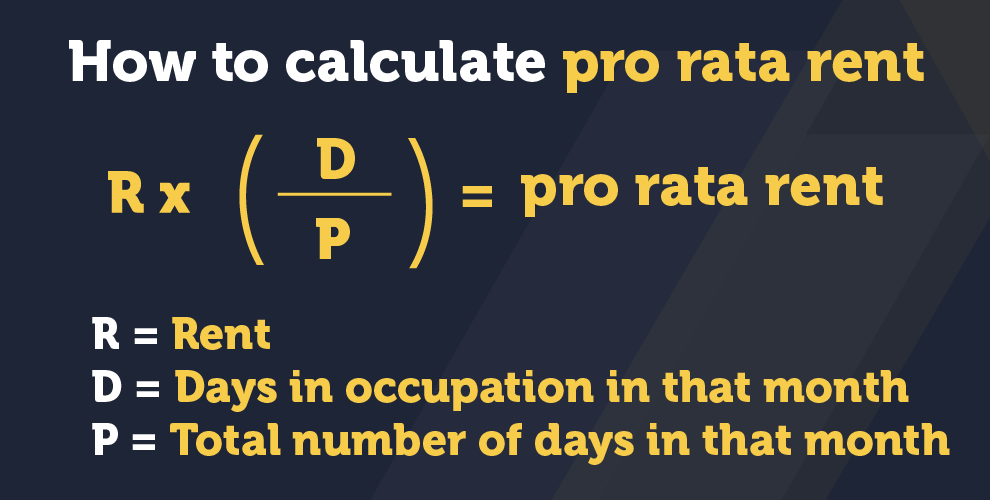Around the beginning and end of tenancies, landlords and tenants often need to calculate pro rata rent. Rather than charging for the full term, monthly rent can be prorated by the day, which should ultimately result in a good relationship between tenant and landlord. But how do you calculate pro rata rent, and when exactly should you do it?
What is pro rata rent?
Firstly, ‘pro rata’ means that the rent cost is calculated in proportion to the time the tenant will be present in the property. Paying full rent for time they are not in the property can seem unfair to tenants, but calculating rent pro rata solves this problem.
If a tenant is occupying a property for only a portion of the rental term, a landlord can charge them prorated rent. For example, if a tenant is only occupying the property for 5 days of the current month, they do not have to pay rent based on the total monthly amount, but rather on the number of days they will actually use the property that month.
Landlords can choose to prorate rent for a number of reasons, including a tenant moving in mid-month, the tenant wanting to stay slightly longer in the property, or if the property is being used as a vacation rental. A landlord may support prorating rent if the tenant is moving into or staying in the property, but they may not be happy to prorate rent if the tenant is moving out prior to the expiry of the lease.
When should rent be prorated?


Landlords should decide when exactly to prorate the rent. If a tenant is moving in on the first few days of the month, it may not make sense to prorate the rent for this period of time. However, if they are moving in mid-month this might be a more sensible time for them to be eligible for pro rata rent. Landlords are not required to prorate rent in most circumstances, but you should check what the requirements are in your area.
Even if a tenant requests a prorated rent when moving out before a lease term ends, they are required to pay the full amount as per their contractual agreement. However, if you want them to leave the property early you may offer a prorated rent as an enticement to move out before the end of the month.
On the other hand, a tenant may want to remain in the property for a few additional days or weeks following the expiry of the lease. If you choose to accept this request, you can consider a prorated rent which involves a minus of the days remaining following the tenant’s vacation of the property.
How to calculate pro rata rent
As discussed, pro rata rent can be calculated for tenants who are moving out part of the way through a rental period, or moving in part of the way through a month.
You can calculate prorated rent using our simple formula.
R x (D/P) = pro rata rent
R = rent
D = days in occupation in that month
P = total number of days in that month


Simply divide the days in occupation by the total number of days in the month, then multiply this number by the monthly rent, and there you have your pro rata rent.
Example of pro rata rent calculator
A tenant is moving into the property part of the way through January and the full rent is £1000. The tenant will occupy the property for 21 days out of 31 days in the month. Your calculations for pro rata rent would look like this:
Rent = £1000
Days in flat/house = 21
Period (Jan) = 31
1000 X (21/31) = 677.45
This makes £677.45 the prorated rent. Simple!
How to calculate maximum deposit sizes pro rata
Tenancy deposits are limited to five weeks’ rent, while holding deposits are limited to one week’s rent, which should be kept in a deposit protection scheme. Therefore, a pro rata calculator method must be used to convert a monthly rent cost into a weekly amount.
In tenancies where the rent is paid monthly, maximum deposit sizes pro rata can be calculated by:
Step 1: Multiplying the monthly rent by 12 (this gives you the total yearly rent)
Step 2: Divide this by 52 (this gives you the value of one week’s rent)
Step 3: Finally, multiple this by either one or five weeks (depending on your deposit scheme) to find the final deposit size
(Monthly rent x 12) / 52 = pro rata weekly rent = maximum holding deposit size
Multiple the weekly rent by five to get the maximum tenancy deposit size.
TIP: Make sure you do not round up while calculating, or you may exceed the legal maximum amount.
Tips for prorating rent
- Choose a policy and write it into your lease agreement. The wording should reflect the method you choose, such as ‘rent will be prorated based on a 30-day period’, or ‘the number of months in the fiscal year’.
- Ensure that the security deposit and the first month’s rent are kept separate from the prorated month amount. It may be sensible to charge the full amount at the time of lease signing and then apply the prorated amount to the second month of tenancy.
- For leap years, you will need to use 366 days in your calculation to ensure an accurate prorated rent amount.
Prorating rent is much simpler than it sounds, and it can provide your tenants with flexibility for move-in dates, which will in turn build trust in you as a landlord, as your tenants will appreciate you billing them for only the time they are occupying the property.



















